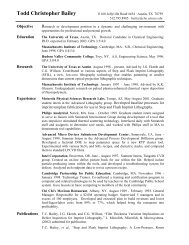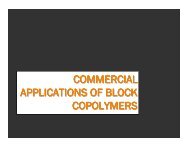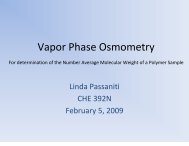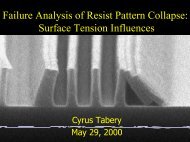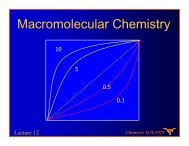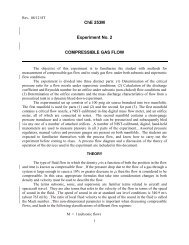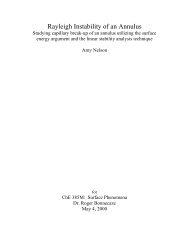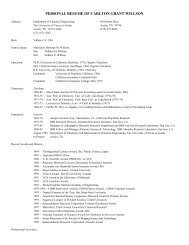MOSFET device - Willson Research Group
MOSFET device - Willson Research Group
MOSFET device - Willson Research Group
You also want an ePaper? Increase the reach of your titles
YUMPU automatically turns print PDFs into web optimized ePapers that Google loves.
Employing Step and Flash Imprint Lithography for<br />
Gate Level Patterning of a <strong>MOSFET</strong> Device<br />
B.J. Smith a , N.A. Stacey a , J.P. Donnelly a , D.M. Onsongo a , T.C. Bailey a ,<br />
C.J. Mackay b , D.J. Resnick c , W.J. Dauksher c , D. Mancini c , K.J. Nordquist c ,<br />
S.V. Sreenivasan b , S.K. Banerjee a , J.G. Ekerdt a , and C.G. <strong>Willson</strong> a†<br />
a University of Texas at Austin, Austin, TX 78712<br />
b Molecular Imprints, Inc., Austin, TX 78758<br />
c Motorola Labs, Tempe, AZ 85284<br />
† willson@che.utexas.edu<br />
ABSTRACT<br />
Step and Flash Imprint Lithography (SFIL) is an alternative lithography technique that enables patterning of sub-100<br />
nm features at a cost that has the potential to be substantially lower than either conventional projection lithography or<br />
proposed next generation lithography techniques. SFIL is a molding process that transfers the topography of a rigid<br />
transparent template using a low-viscosity, UV-curable organosilicon solution at room temperature and with minimal<br />
applied pressure. 1 Employing SFIL technology we have successfully patterned areas of high and low density, semidense<br />
and isolated lines down to 20 nm, 2 and demonstrated the capability of layer-to-layer alignment. 3 We have also<br />
confirmed the use of SFIL to produce functional optical <strong>device</strong>s including a micropolarizer array consisting of<br />
orthogonal 100 nm titanium lines and spaces fabricated using a metal lift-off process. 4 This paper presents a<br />
demonstration of the SFIL technique for the patterning of the gate level in a functional <strong>MOSFET</strong> <strong>device</strong>.<br />
Keywords: Step and Flash Imprint Lithography, Alignment, Planarization, Etching, <strong>MOSFET</strong><br />
1. INTRODUCTION<br />
Step and Flash Imprint Lithography (SFIL) is a low-cost, high throughput approach to fabricating features in the<br />
sub-100 nm regime. SFIL differs from conventional lithography techniques in that it does not use projection optics or<br />
complex lenses, thereby significantly reducing the capital cost of the equipment. The process operates at room<br />
temperature and makes use of chemical and low pressure mechanical processes to transfer patterns. Many nano-imprint<br />
lithography processes have emerged over the last few years, all of which use the topography defined on a template to<br />
create a pattern on a substrate. 5-9 SFIL differs from these other techniques in that it uses a low viscosity, photocurable<br />
liquid and a transparent template eliminating the need for high temperatures and pressures. This alleviates concerns<br />
with overlay alignment accuracy and the effects of the thermal cycle times on the imprint process.<br />
The SFIL process is illustrated in Figure 1. A silicon substrate is first spin-coated with an organic transfer layer. Then<br />
a small amount of low viscosity, photopolymerizable, organosilicon solution (etch barrier) is dispensed onto the wafer<br />
in the area to be imprinted. The etch barrier formulation used in these experiments consisted of 15%(w/w) ethylene<br />
glycol diacrylate (Aldrich), 44% (3-acryloxypropyl)tris(trimethylsiloxy)silane (SIA0210.0, Gelest), 37% t-butyl<br />
acrylate (Lancaster), and 4% 2-hydrozy-2-methyl-1-phenyl-propan-1-one (Darocur 1173, Ciba). A template bearing<br />
1X patterned relief structures, written by electron beam lithography 2 and surface-treated 10 with a fluorocarbon film, is<br />
aligned over the dispensed solution and lowered to make contact to the substrate. This displaces the etch barrier and<br />
fills the patterned relief structures on the template. Once filling has occurred, the area is irradiated with broadband<br />
ultraviolet light through the back side of the template and cross-linking of the polymer occurs. The template is then<br />
separated from the substrate, leaving an organosilicon relief pattern identical to the template relief pattern. The etching<br />
is performed in a two-step process. The first is a halogen etch that is referred to as the “breakthrough etch” because it is<br />
used to break through the undisplaced etch barrier and expose the underlying organic transfer layer. Finally, an<br />
anisotropic oxygen reactive ion etch is then used to transfer the imprinted features to the underlying substrate.
Dispense<br />
Imprint<br />
Expose<br />
Separate<br />
Breakthrough<br />
Etch<br />
Transfer Etch<br />
etch barrier<br />
UV Cure<br />
template<br />
release<br />
treatment<br />
transfer<br />
layer<br />
residual<br />
layer<br />
The incorporation of the<br />
SFIL process in the<br />
fabrication of a metal oxide<br />
semiconductor field effect<br />
transistor (<strong>MOSFET</strong>),<br />
presented many challenges.<br />
A planarization process and<br />
the ability to perform layerto-layer<br />
alignment through<br />
the template have been<br />
demonstrated. This paper<br />
describes these challenges<br />
and the steps taken to<br />
fabricate the first working<br />
electrical <strong>device</strong> using SFIL<br />
technology. For proof of<br />
concept purposes SFIL was<br />
used only for the most critical<br />
dimension in the <strong>MOSFET</strong><br />
process flow; the fabrication<br />
of the gate level.<br />
Figure 1. The Step and Flash Imprint Lithography process<br />
2. SFIL GATE FABRICATION PROCESS FLOW<br />
Figure 2(a) shows a simplified <strong>MOSFET</strong> process flow for the fabrication of the transistor gate. In this process, the<br />
starting substrate is a wafer on which the field oxide and the gate oxide have been grown, the poly-Si deposited, and the<br />
oxide hard mask is in place. This would be spin-coated with resist, exposed, and developed leaving the patterned resist<br />
features. These resist features then serve as an etch mask used to pattern the hard mask that is ultimately the pattern<br />
that defines the underlying poly-Si for the transistor gate. The SFIL technique replaces the spin-coating and exposing<br />
steps used in conventional lithography with the process flow seen in Figure 2(b) and described below.<br />
Gate<br />
Spin-Coat Resist<br />
Expose/Develop<br />
Hard Mask<br />
Poly-Si<br />
Field<br />
Oxide<br />
Planarization/Imprint<br />
Breakthrough Etch<br />
Imprinted<br />
Features<br />
Planarization<br />
Layer<br />
Adhesion<br />
Layer<br />
Hard Mask Etch<br />
Transfer Etch<br />
Poly-Si Etch<br />
(a)<br />
(b)<br />
Figure 2. (a) Simplified industry <strong>MOSFET</strong> process flow for gate fabrication.<br />
(b) Additional steps employed by SFIL.
2.1. Planarization<br />
The incorporation of an organic planarization layer (transfer layer) that is imprinted with a featureless template to<br />
normalize the effects of the underlying topography on the imprint surface has been detailed previously. 4 For this<br />
application, the 250 nm step generated during the growth of the field oxide needed to be planarized in order to allow<br />
gate pattern imprinting. This was achieved by first spin-coating the substrate with poly(hydroxystyrene) (PHS). To<br />
provide a conformal coating across the wafer that averaged 200 nm in thickness. PHS also provided an adhesion<br />
medium for the planarization layer that was found to have poor adhesion to the oxide surface.<br />
Following the conformal coating of the PHS adhesion layer, an<br />
imprint was performed to planarize the surface. This was done by<br />
first manually dispensing a small amount of ethylene glycol<br />
diacrylate (Aldrich) containing a photoinitiator and imprinting with a<br />
blank, featureless, optically flat template. The imprint was<br />
performed using the automated SFIL Multi-Imprint Machine at the<br />
University of Texas, which has been described previously. 11<br />
Planarization of the underlying topography was confirmed using a<br />
KLA-Tencor Alphastep 200 profilometer. This planarization layer<br />
also served as the transfer layer described earlier in the SFIL process.<br />
The film had an average thickness of 700 nm. A scanning electron<br />
microscopy image (SEM) of the planarization layer is shown in<br />
Figure 3.<br />
2.2. Alignment and Imprinting<br />
topography<br />
imprint<br />
surface<br />
Figure 3. Planarization layer over underlying<br />
250nm topography.<br />
The ability to perform alignment in SFIL has been described in detail previously. 3 This work was performed on a<br />
Canon 501 mask aligner at that has been modified for the SFIL process. This tool employs optical microscopy to<br />
detecting alignment error, making the corresponding corrections in X, Y, and theta, and performing the UV exposure to<br />
complete the imprint. The process was performed by dispensing a small amount of etch barrier on the wafer in the area<br />
to be imprinted. The wafer was then raised on a hydraulic piston into close proximity of the template. As the etch<br />
barrier filled the template relief patterns, a thin layer of fluid prevents the wafer from actually making contact with<br />
template. This thin fluid film, referred to as the residual layer, acts as both a lubricant and a damping agent allowing<br />
adjustment in the alignment to be made. The alignment marks on the wafer surface and the template can be viewed<br />
through the backside of the template and fine alignment was performed with minimal optical errors.<br />
Alignment between the underlying poly-Si and the SFIL patterned template was required to define the gate<br />
structures over the active areas of the wafer. Rough alignment in the theta direction was performed using a simple<br />
cross-in-box pattern. The cross feature was previously defined on the wafer surface and the box pattern was present in<br />
the relief image on the template. Fine alignment was performed using Vernier marks in the X and Y directions. With<br />
the center marks on the vernier aligned, the resulting overlay error was found to be less than 0.25m. Following<br />
alignment, the imprint area was irradiated with UV light, polymerizing the etch barrier and leaving an organosilicon<br />
relief image that is a replica of the template pattern.<br />
2.3. Etching<br />
Transferring the imprinted pattern to the underlying substrate required a two step etch process. Both processes are<br />
derivatives of commonly used etch processes and do not require the addition of any exotic etch gases. The final etch<br />
profiles are high-aspect ratio, organic features analogous to patterned resist features in conventional lithography. The<br />
etching done in this research was performed on a PlasmaTherm 790 Series reactive ion etcher (RIE).<br />
An anisotropic halogen RIE rich in fluorine was used to break-through the residual layer exposing the underlying<br />
transfer layer. This etch was performed with a combination of 30 standard cubic centimeters per minute (sccm) CHF 3<br />
and 5 sccm O 2 at a pressure of 17 mTorr and RF power of 450W. The use of a halogen gas, CHF 3 in this case, is
equired by the organosilicon nature of the etch barrier. This etch is similar to a standard SiO 2 etch that would be<br />
performed in modern integrated circuit (IC) processing. Following the break-through etch, the remaining siliconcontaining<br />
features serve as an etch mask to transfer the pattern to the underlying substrate. This “transfer etch” was<br />
achieved with a standard, anisotropic, oxygen RIE using 8 sccm O 2 at 5 mTorr and RF power of 400W. An SEM<br />
image of a polymer gate structure after both the breakthrough and transfer etch is shown in Figure 4.<br />
The etcher used in these experiments was not equipped with an<br />
end-point detection system. Therefore, each etch had to be<br />
performed for a set period of time based on the measured etch rates<br />
and estimated residual layer thickness. The etch rates were<br />
determined experimentally by masking off a portion of the imprinted<br />
area with a piece of another wafer and etching for varying lengths of<br />
time. Each sample was examined with a profilometer and confirmed<br />
via cross-sectional images on a SEM. The etch rate of the etch<br />
barrier was found to be approximately 90 nm/min while the EGDA<br />
and the PHS etched at rates of 80 nm/min and 45 nm/min,<br />
respectively.<br />
Following the transfer of the feature to the underlying substrate,<br />
standard etch processes were used to pattern the hard mask and the<br />
poly-Si. The hard mask etch uses halogen etch chemistry and the<br />
standard poly-Si etch incorporated a combination of bromine and<br />
chlorine.<br />
Gate pattern over the active area<br />
Figure 4. Gate pattern following the breakthrough<br />
etch and transfer etch.<br />
3. RESULTS<br />
3.1. Completed <strong>MOSFET</strong> Device<br />
The remaining steps in the fabrication of this <strong>MOSFET</strong> <strong>device</strong> were completed using conventional processing<br />
techniques. Following gate patterning, each wafer underwent implantation, isolation oxide growth, contact patterning,<br />
and aluminum deposition. An example of one of the completed <strong>device</strong>s used in these experiments is shown in Figure 5.<br />
These <strong>device</strong>s were made with a process that did not incorporate an anti-punch-through implant, source/drain<br />
extensions, or silicide gate cap, features that are required to get good performance from short gate lengths. These steps<br />
are within our processing capability and will be included in future <strong>device</strong> fabrication processes.<br />
3.2. Electrical Data<br />
Following processing, the completed <strong>device</strong>s were electrically<br />
tested. Both drain current vs. drain voltage (I d vs. V d ) and drain<br />
current vs. gate voltage (I d vs. V g ) curves were obtained and can be<br />
seen in figures 6 and 7, respectively. These I-V curves confirm the<br />
functionality of the fabricated <strong>MOSFET</strong> <strong>device</strong>s and the successful<br />
incorporation of SFIL in creating a working electrical <strong>device</strong>. The<br />
electrical data are also consistent with other electrical <strong>device</strong>s<br />
fabricated with conventional lithographic techniques using similar<br />
processing equipment.<br />
Electrical<br />
Test Pad<br />
Contacts<br />
Drain<br />
Source<br />
Electrical<br />
Test Pad<br />
Electrical<br />
Test Pad<br />
Gate<br />
Figure 5. Completed <strong>MOSFET</strong> <strong>device</strong>.
I d (A)<br />
1.0E+04<br />
1.0E+02<br />
1.0E+00<br />
Vd=-0.1V<br />
Vd=-0.6V<br />
Vd=-1.1V<br />
Vd=-1.6V<br />
Vd=-2.1V<br />
1.0E-02<br />
1.0E-04<br />
1.00<br />
0.50<br />
0.00<br />
-0.50<br />
V g (V)<br />
-1.00<br />
SS=133.58mV/decade<br />
V t =0.161V<br />
-1.50<br />
Figure 6. I d vs V g curves of SFIL P<strong>MOSFET</strong>, L=2m, W=23m<br />
-2.00<br />
-1.0E-03<br />
-7.5E-04<br />
Vg=0.1V<br />
Vg=-0.4V<br />
Vg=-0.9V<br />
Vg=-1.4V<br />
I d (A)<br />
-5.0E-04<br />
-2.5E-04<br />
0.0E+00<br />
0.00 -0.25 -0.50 -0.75 -1.00 -1.25<br />
V d (V)<br />
Figure 7. I d vs V d curves of SFIL P<strong>MOSFET</strong>, L=2m, W=23m<br />
-1.50<br />
4. CONCLUSIONS<br />
Step and Flash Imprint Lithography is capable of producing an electrical <strong>device</strong>. This implies that none of the<br />
SFIL processing steps impair its ability to fabricate a working <strong>MOSFET</strong> transistor. The low pressure, room<br />
temperature nature of the SFIL process and the use of transparent imprint templates that enables layer-to-layer<br />
alignment makes SFIL particularly well suited for patterning critical features. In this paper, we have confirmed the use<br />
of a planarization layer to normalize local topography, demonstrated layer-to-layer alignment of critical features, and<br />
developed the etch processes to transfer high-aspect ratio features. Planarization was achieved by imprinting an organic<br />
photocurable solution with a featureless template. Overlay alignment was performed through the template by<br />
superimposing the alignment marks on the template with the marks on the wafers. Etching was completed with a two<br />
step etch process that involved a halogen break-through etch followed by an oxygen RIE transfer etch. The completed<br />
<strong>MOSFET</strong> <strong>device</strong>s were electrically tested and the corresponding I-V curves confirm the functionality of these <strong>device</strong>s.
The objective of this research was to demonstrate the use of SFIL in the fabrication of a working electrical <strong>device</strong>.<br />
Another template is being generated that will include 30 nm transistor gates patterns. The acquisition of this template<br />
and access to an etcher with a higher degree of anisotropy and an end-point detection system will enable us to use SFIL<br />
to produce functional <strong>MOSFET</strong> <strong>device</strong>s with gate lengths in deep sub-100 nm regime.<br />
5. ACKNOWLEDGMENTS<br />
The authors would like to thank DARPA (MDA972-97-1-0010) and SRC (96-LC-460 for their support of this work.<br />
We also thank .International SEMATECH for assistance and support, especially Daniel Miller, David Stark, Laurie<br />
Dennig and the members of the failure analysis group.<br />
6. REFERENCES<br />
1 M. Colburn et al., Proc. SPIE 3676, 379 (1999).<br />
2 D.J. Resnick et al., Proc. SPIE 4688, 205 (2002).<br />
3 B.J. Choi et al., Proc. SPIE 4342, 436 (2001).<br />
4 D M. Colburn et al., Proc. SPIE 3679, 2965 (2000)<br />
5 D. Wang et al., Appl. Phys. Lett. 70, 1593 (1997).<br />
6 J. Haisma et al., J. Vac. Sci. Technol. B 14, 4124 (1996)<br />
7 S.Y. Chou, P.R. Krauss, & P.J. Renstrom, J. Vac. Sci. Tech. B 14, 4129 (1996)<br />
8 T.K. Widden et al., Nanotechnology. 7, 447 (1996)<br />
9 Y. Xia & G.M. Whitesides, Angew. Chem. Int. Ed. Engl. 37, 550 (1998)<br />
10 Bailey, T.C., et al., J. Photopolymer Sci. Tech., 15(3): p. 481 (2002)<br />
11 Choi, B.J.., et al., Proc., DETC2000, MECH-14145, 861. (2000)



